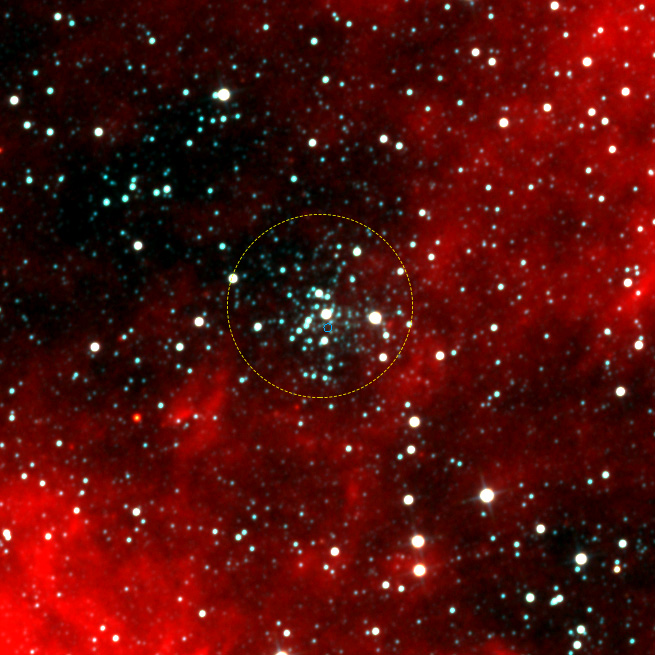
Revealing for the first time the history of Chemistry and Dynamics of the Open cluster IC 166 in the outer regions of our Galaxy
An international group of researchers, including astronomers from the University of Concepción (Dr. José G. Fernández-Trincado, Dr. Baitian Tang and Dr. Douglas Geisler), has conducted an unprecedented study of the spatial, chemical and kinematics distribution of the stars, of the open cluster IC 166 located in the outer regions of the Milky Way. The team was led by José Schiappacasse-Ulloa, a Master's student in the Department of Astronomy of the Universidad de Concepción, and had collaborators in several countries, including the US, Brazil, Spain, France and Mexico. The results of the research will be published in a few days in the specialized journal “The Astronomical Journal”. The work uses precise data from the Gaia Mission in combination with Apache Point Observatory data from the APOGEE / SDSS-IV collaboration (Sloan Digital Sky Survey IV).
"The Open Cumulus IC 166 is a very exciting group of stars because it is an excellent laboratory, in terms of age and chemical composition located in remote regions of the Milky Way, which allows us to assemble the great puzzle that will help us understand how our Galaxia itself has been formed and evolved”, said José Schiappacasse-Ulloa.
The open cluster known as IC 166 contains a population of a hundred relatively young stars. Some of them are just a billion years old (even 4 times younger than our own Sun), and are gravitationally linked to each other, forming the well-known grouping of stars that bears the name of the open IC 166 cluster. The conditions in which we find many of them today, we believe that it is very similar to the environment in which many of the young stars that assemble the disk of our own Galaxy could have formed. Studying how and why these open clusters form and evolve to join the disk of the Milky Way, provides astronomers with a better understanding of how the galaxies that we now see throughout the Universe are assembled, grown and evolved, at least in those galaxies similar to the Milky Way.
This project is part of the Sloan Digital Sky Survey or SDSS-IV, a large-scale project, of which Universidad de Concepción is a partner with nearly forty institutions around the world and whose goal is to study the chemical and dynamic history of stars and galaxies in a considerable fraction of the sky. The researchers used, from this survey, the advanced spectrographs of the so-called Galactic Evolution Experiment of the Apache Point Observatory (Apache Point Observatory Galactic Evolution Experiment or APOGEE, which as its name indicates are mounted from the main telescope of the survey in that observatory, which has a main optics of 2.5m in diameter). These instruments are capable of observing hundreds of stars in a single exposure, and that is what allowed to complete a wide survey of the open cluster IC 166. The stellar spectra provide individual physical characteristics of young stars, such as their temperatures and surface gravities, but they can also provide their speed in the radial direction (that is, the researchers can know if they move away or approach us and how fast they do it), and also their chemical composition. The team also used data recently published by the Gaia Satellite consortium, a space observatory that provides, with great precision, information about the distances to which the stars are located, and the movements they make over the celestial vault. In this way, astronomers were able to deduce for the first time the orbital trajectory of the open cluster IC 166. "By combining the precise data of APOGEE and Gaia, we were able to measure the chemical composition of the cluster, as well as to construct its orbital trajectory around the Milky Way. "Said José Schiappacasse-Ulloa. All these pieces together provide the best estimates to date of the chemical composition and dynamics of the open cluster IC 166.
"This detailed work gave us as a result that the open cluster IC 166 shares the same chemical traces as the rest of the young stars of the Milky Way disk, but dynamically differs from this population, which gives us clues that some internal dynamic process in our own galaxy we played an important role in the outer regions of our own Galaxy, which motivates us to examine and refine the current dynamics models of the Milky Way", concluded José G. Fernández-Trincado, Fondecyt Postdoctoral Researcher at the Department of Astronomy of the Universidad de Concepción.
To see a preliminary version of the article (in English), visit https://arxiv.org/abs/1806.09575

The Open Cumulus IC 166: This image shows an image in false colors, the grouping of stars belonging to the open cluster IC 166, which are within the circumference of dashed lines. WISE image.
Comunicaciones Departamento de Astronomía UdeC




